Avoid having your Nedbank accounts stolen via scam emails
Phishing/ScamAlso Known As: "Nedbank" phishing email
Get free scan and check if your device is infected.
Remove it nowTo use full-featured product, you have to purchase a license for Combo Cleaner. Seven days free trial available. Combo Cleaner is owned and operated by RCS LT, the parent company of PCRisk.com.
What kind of email is "Nedbank"?
After inspecting this "Nedbank" email, we determined that it is fake. It is presented as a notification regarding an electronic account statement. This is a lure to trick recipients into visiting a phishing website targeting Nedbank log-in credentials.
Victims of this scam mail risk having their online bank accounts stolen. It must be stressed that this email is in no way associated with the real Nedbank Group.

"Nedbank" email scam overview
The scam email with the subject "Nedbank Current Account Statement - 20240808" (may vary) is disguised as a notification from Nedbank. The message states that the recipient can view their account statement via a password-protected e-statement.
It must be emphasized that this email is fake, and it is not associated with the Nedbank Group financial service group.
The "VIEW eSTATEMENT HERE" button in this letter redirects to a phishing site. The website mimics the Nedbank sign-in page. Log-in credentials entered into this site are recorded and sent to the cyber criminals behind this spam campaign. Stolen finance-related accounts can be variously abused, including to make fraudulent transactions and online purchases.
To summarize, victims of scam mail like this fake "Nedbank" email can experience severe privacy issues, financial losses, and identity theft.
If you have entered your log-in credentials into a phishing website or file – immediately change the passwords of all possibly compromised accounts and inform their official support. And if the exposed information is personally identifiable or otherwise highly sensitive – you may also need to contact the appropriate authorities.
| Name | "Nedbank" phishing email |
| Threat Type | Phishing, Scam, Social Engineering, Fraud |
| Disguise | Electronic account statement from Nedbank |
| Related Domains | ssecure105sec[.]com, secure-allreviewschecked[.]es |
| Detection Names (ssecure105sec[.]com) | Combo Cleaner (Malware), ESET (Phishing), Fortinet (Phishing), Kaspersky (Phishing), Full List Of Detections (VirusTotal) |
| Serving IP Address (ssecure105sec[.]com) | 104.21.54.162 |
| Symptoms | Unauthorized online purchases, changed online account passwords, identity theft, illegal access of the computer. |
| Distribution methods | Deceptive emails, rogue online pop-up ads, search engine poisoning techniques, misspelled domains. |
| Damage | Loss of sensitive private information, monetary loss, identity theft. |
| Malware Removal (Windows) |
To eliminate possible malware infections, scan your computer with legitimate antivirus software. Our security researchers recommend using Combo Cleaner. Download Combo CleanerTo use full-featured product, you have to purchase a license for Combo Cleaner. 7 days free trial available. Combo Cleaner is owned and operated by RCS LT, the parent company of PCRisk.com. |
Phishing spam campaign examples
"SharePoint - ACH-Wire Authorization", "Microsoft Office 365 - Password Notification", "SurePayroll", "Reserve Server", and "Email Has Been Suspended Due To Policy Violations" are just some of our newest articles on phishing emails.
Various scams are promoted through spam campaigns, and they are utilized in malware proliferation. Spam emails are often poorly constructed and full of spelling/grammatical errors, but they can be competently made and even believably disguised as messages from legitimate entities (e.g., companies, service providers, institutions, authorities, etc.).
Due to how widespread spam mail is and how well-crafted it can be – we highly recommend approaching incoming emails, PMs/DMs, SMSes, and other messages with caution.
How do spam campaigns infect computers?
Spam campaigns are commonly used by cyber criminals to proliferate malware. Deceptive emails and messages can include malicious files as attachments or download links. These files can be executables (.exe, .run, etc.), archives (RAR, ZIP, etc.), documents (PDF, Microsoft Office, Microsoft OneNote, etc.), JavaScript, and so on.
When an infectious file is opened – the malware download/installation is jumpstarted. However, some formats require additional actions to initiate infection processes. For example, Microsoft Office files need users to enable macro commands (i.e., editing/content), while OneNote documents require them to click embedded links or files.
How to avoid installation of malware?
It is important to treat incoming emails and other messages with care. Attachments or links found in suspect/irrelevant mail must not be opened, as they can be malicious.
However, malware is not spread exclusively via spam mail. Therefore, we recommend being vigilant while browsing since the Internet is full of well-disguised deceptive and malicious content.
Another recommendation is to download only from official and verified channels. Additionally, all programs must be activated and updated using legitimate functions/tools, as illegal activation ("cracking") tools and third-party updaters can contain malware.
We must stress that having a dependable anti-virus installed and kept updated is paramount to device and user safety. Security software must be used to run regular system scans and to remove detected threats and issues. If you've already opened malicious attachments, we recommend running a scan with Combo Cleaner Antivirus for Windows to automatically eliminate infiltrated malware.
Text presented in the "Nedbank" spam email letter:
Subject: Nedbank Current Account Statement - 20240808
Credit card
View your attached
e-statement
see money differently
NEDBANK
Dear Cardholder
We attach your card e-statement, which is password-protected to ensure confidentiality. To view your e-statement you'll need Adobe Reader, which you can download from adobe.com if you don't already have it.
VIEW eSTATEMENT HERE
The password to open the document is the identity or password number you used to open your account.
If you have any questions, call us on 0800 555 111 or 011 710 4710.
For more information on your credit card benefits or other Nedbank products, visit nedbank.co.za.
Kind regards
The Nedbank Team
How to verify the integrity and origin of this email
1 Check whether the message has been signed by the sender.
2 Be on the lookout for a security warning when opening this email to alert you that the message might have been tampered with, or that it might not come from the supposed sender.
3 Simply click on the red ribbon icon and choose the option to view the digital identity or the certificate to verify the sender's digital identity.
Disclaimer | nedbank.co.za | Contact us
T & Cs apply. Nedbank Ltd Reg No 1951/000009/06. Licensed financial services and registered credit provider (NCRCP16).
Screenshot of the fake Nedbank website promoted by this spam campaign:
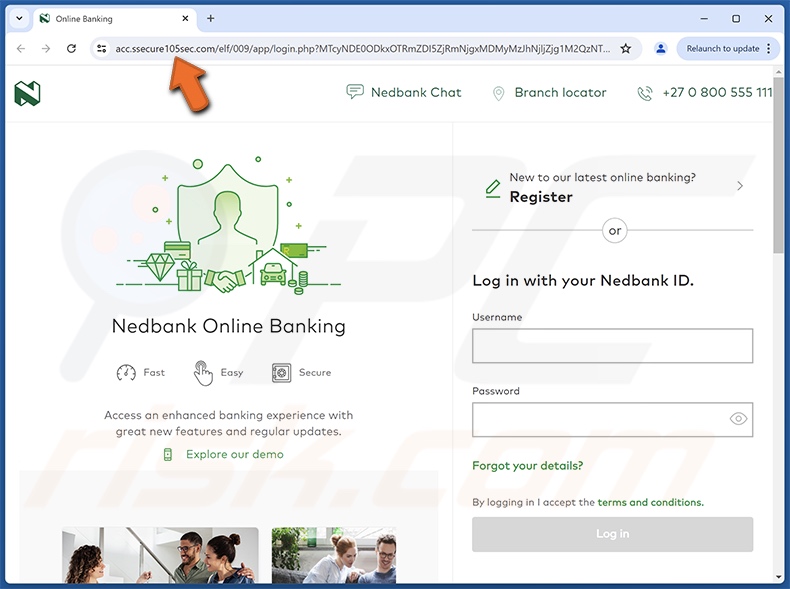
Other examples of Nedbank-themed spam emails:
Sample 1:
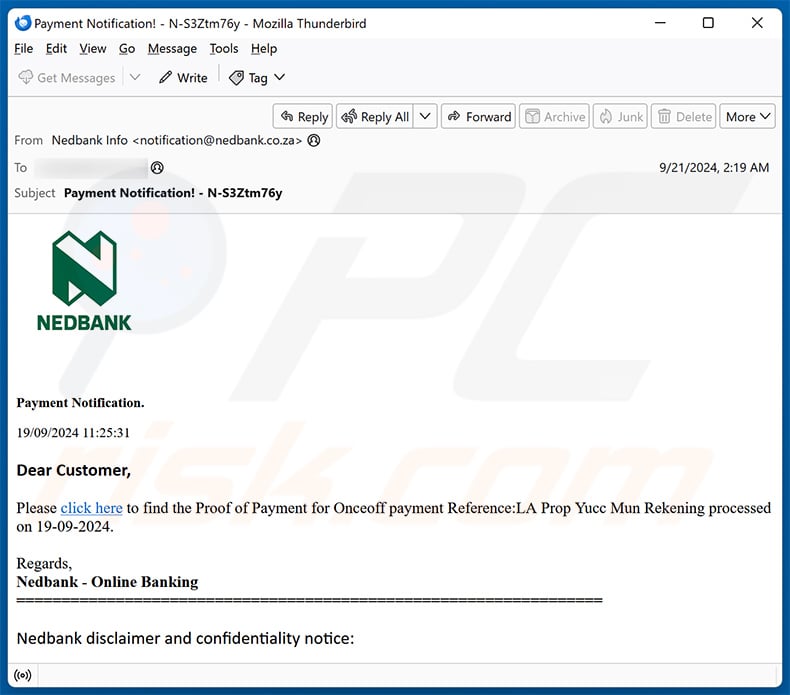
Text presented within:
Subject: Payment Notification! - N-S3Ztm76y
NEDBANK
Payment Notification.
19/09/2024 11:25:31
Dear Customer,
Please click here to find the Proof of Payment for Onceoff payment Reference:LA Prop Yucc Mun Rekening processed on 19-09-2024.
Regards,
Nedbank - Online Banking
Sample 2:
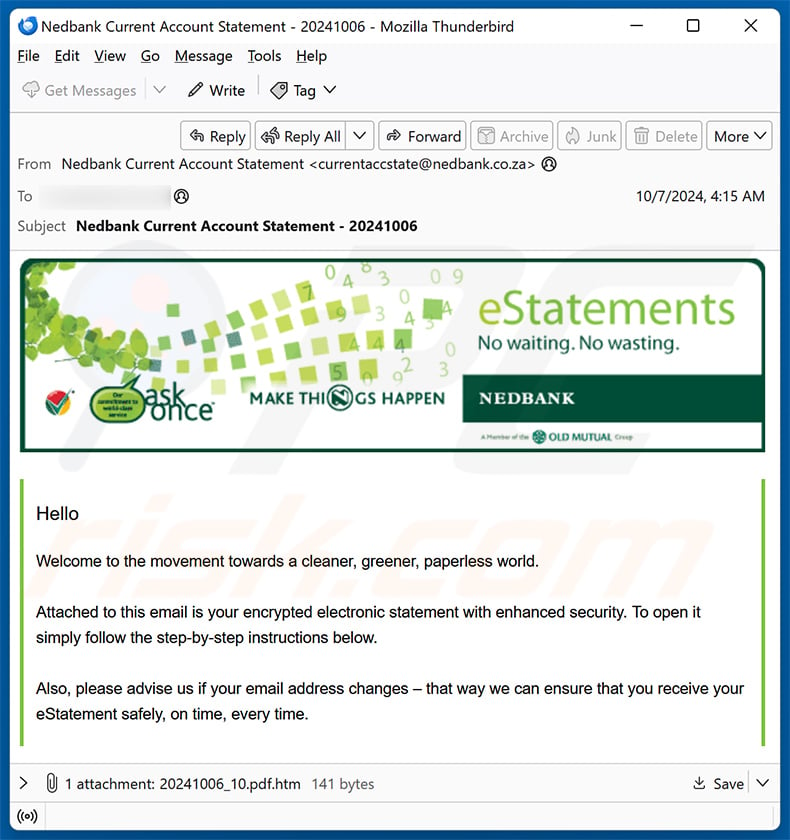
Text presented within:
Subject: Nedbank Current Account Statement - 20241006
HelloWelcome to the movement towards a cleaner, greener, paperless world.
Attached to this email is your encrypted electronic statement with enhanced security. To open it simply follow the step-by-step instructions below.
Also, please advise us if your email address changes – that way we can ensure that you receive your eStatement safely, on time, every time.
Sample 3:
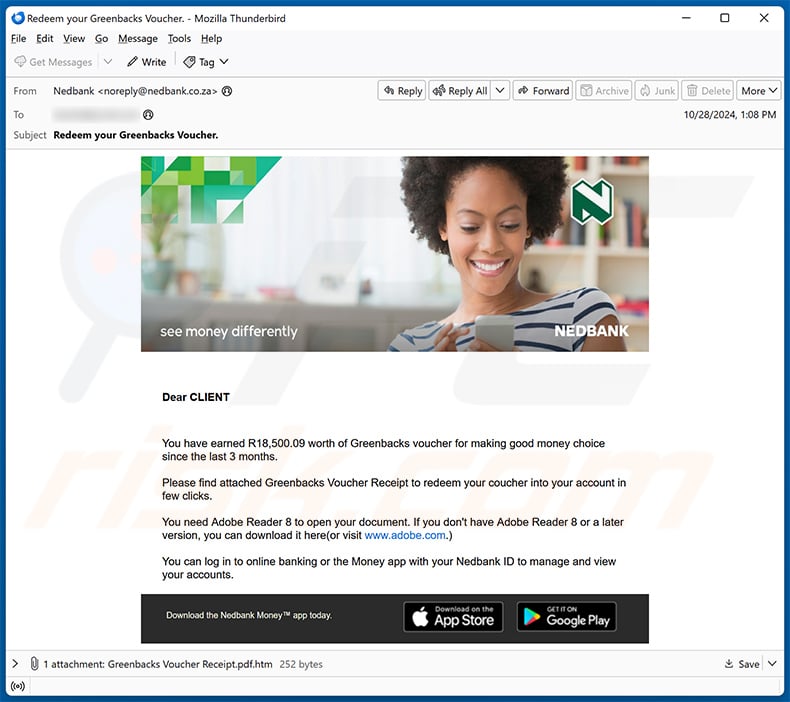
Text presented within:
Subject: Redeem your Greenbacks Voucher.
NEDBANK
Dear CLIENT
You have earned R18,500.09 worth of Greenbacks voucher for making good money choice since the last 3 months.
Please find attached Greenbacks Voucher Receipt to redeem your coucher into your account in few clicks.
You need Adobe Reader 8 to open your document. If you don't have Adobe Reader 8 or a later version, you can download it here(or visit www.adobe.com.)
You can log in to online banking or the Money app with your Nedbank ID to manage and view your accounts.
Download the Nedbank Money™ app today.
A secure and convenient way to manage your money on the go. Now you can bank anytime, anywhere. Discover a new way to visualise and use your money.
If you require more information, feel free to contact us via LiveChat on our Digital Channels or call us on 0800 555 111.
Yours sincerely
Your Nedbank Team
Sample 4:
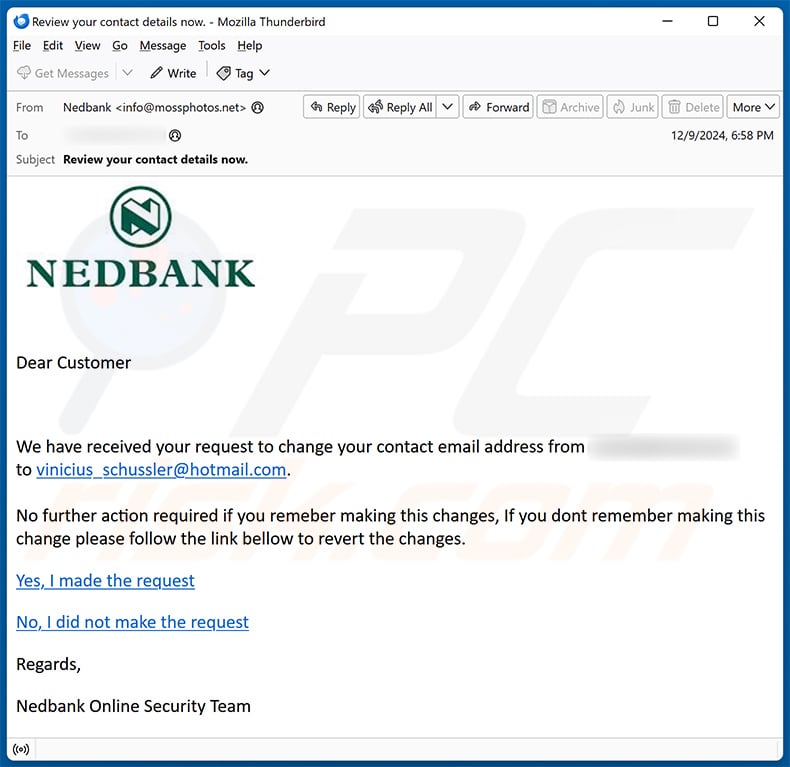
Text presented within:
Subject: Review your contact details now.
Nedbank
Dear Customer
We have received your request to change your contact email address from - to vinicius_schussler@hotmail.com.
No further action required if you remeber making this changes, If you dont remember making this change please follow the link bellow to revert the changes.
Yes, I made the request
No, I did not make the request
Regards,
Nedbank Online Security Team
Sample 5:
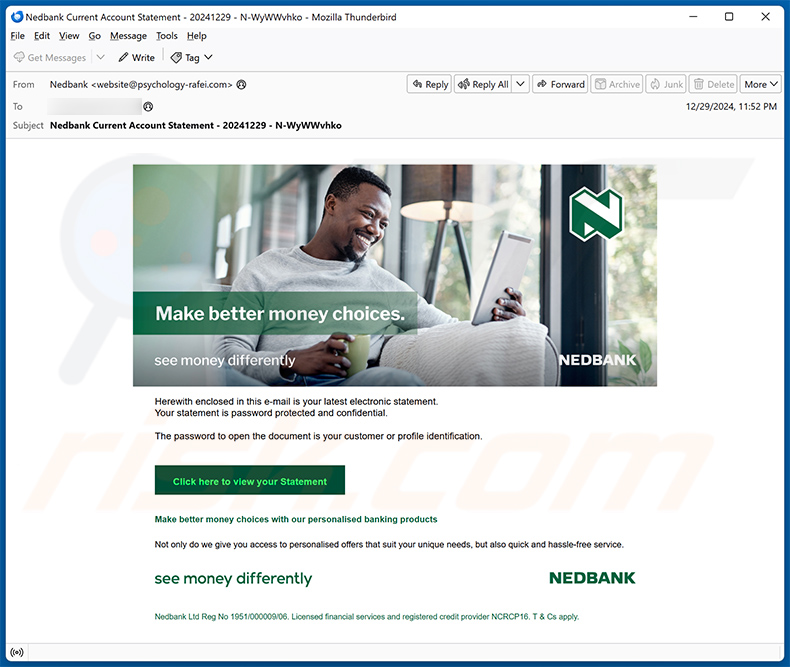
Text presented within:
Subject: Nedbank Current Account Statement - 20241229 - N-WyWWvhko
Make better money choices
Herewith enclosed in this e-mail is your latest electronic statement.
Your statement is password protected and confidential.
The password to open the document is your customer or profile identification.
Click here to view your StatementMake better money choices with our personalised banking products
Not only do we give you access to personalised offers that suit your unique needs, but also quick and hassle-free service.
see money differentlyNedbank Ltd Reg No 1951/000009/06. Licensed financial services and registered credit provider NCRCP16. T & Cs apply.
Screenshot of the promoted phishing site:
![Fake Nedbank website - secure-allreviewschecked[.]es -promoted via spam email (2025-01-02)](/images/stories/screenshots202501/nedbank-email-scam-update-2025-01-02-phishing-site.jpg)
Sample 6:
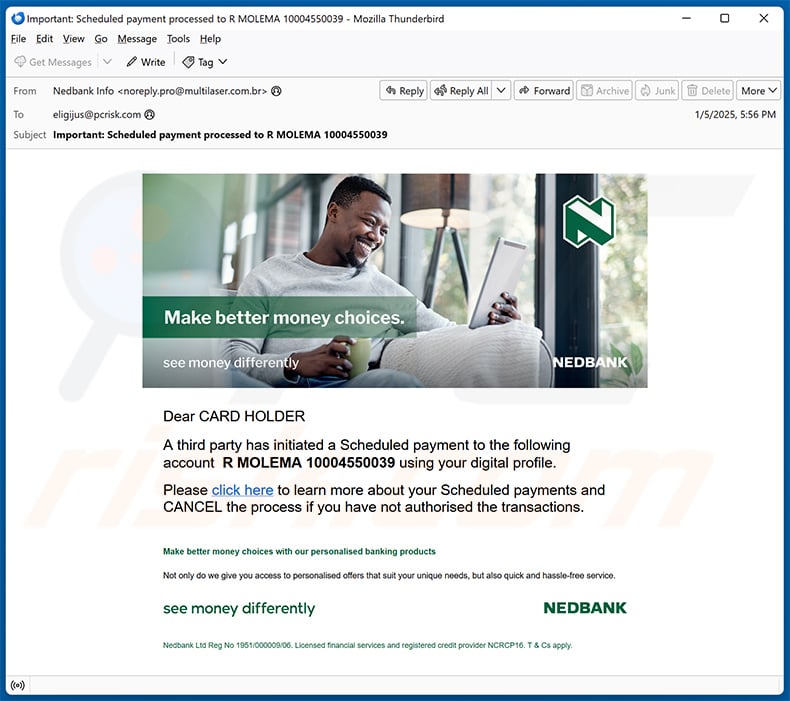
Text presented within:
Subject: Important: Scheduled payment processed to R MOLEMA 10004550039
Make better money choices
Dear CARD HOLDER
A third party has initiated a Scheduled payment to the following account R MOLEMA 10004550039 using your digital profile.
Please click here to learn more about your Scheduled payments and CANCEL the process if you have not authorised the transactions.
Make better money choices with our personalised banking products
Not only do we give you access to personalised offers that suit your unique needs, but also quick and hassle-free service.
see money differentlyNedbank Ltd Reg No 1951/000009/06. Licensed financial services and registered credit provider NCRCP16. T & Cs apply.
Sample 7:
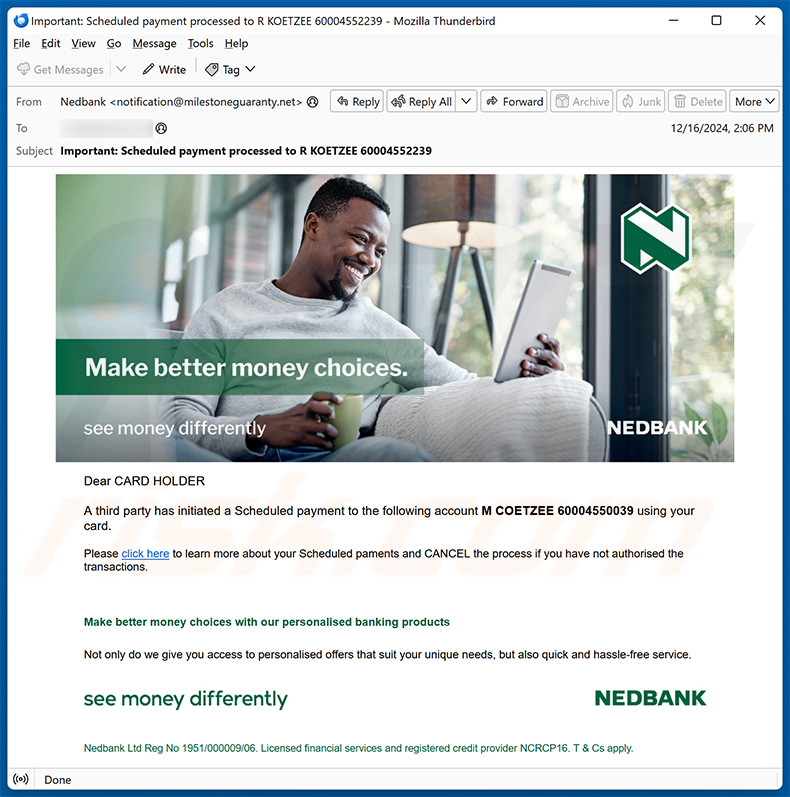
Text presented within:
Subject: Important: Scheduled payment processed to R KOETZEE 60004552239
Make better money choices
see money differently
NEDBANKDear CARD HOLDER
A third party has initiated a Scheduled payment to the following account M COETZEE 60004550039 using your card.
Please click here to learn more about your Scheduled paments and CANCEL the process if you have not authorised the transactions.Make better money choices with our personalised banking products
Not only do we give you access to personalised offers that suit your unique needs, but also quick and hassle-free service.
see money differentlyNedbank Ltd Reg No 1951/000009/06. Licensed financial services and registered credit provider NCRCP16. T & Cs apply.
Instant automatic malware removal:
Manual threat removal might be a lengthy and complicated process that requires advanced IT skills. Combo Cleaner is a professional automatic malware removal tool that is recommended to get rid of malware. Download it by clicking the button below:
DOWNLOAD Combo CleanerBy downloading any software listed on this website you agree to our Privacy Policy and Terms of Use. To use full-featured product, you have to purchase a license for Combo Cleaner. 7 days free trial available. Combo Cleaner is owned and operated by RCS LT, the parent company of PCRisk.com.
Quick menu:
- What is "Nedbank" phishing email?
- Types of malicious emails.
- How to spot a malicious email?
- What to do if you fell for an email scam?
Types of malicious emails:
![]() Phishing Emails
Phishing Emails
Most commonly, cybercriminals use deceptive emails to trick Internet users into giving away their sensitive private information, for example, login information for various online services, email accounts, or online banking information.
Such attacks are called phishing. In a phishing attack, cybercriminals usually send an email message with some popular service logo (for example, Microsoft, DHL, Amazon, Netflix), create urgency (wrong shipping address, expired password, etc.), and place a link which they hope their potential victims will click on.
After clicking the link presented in such email message, victims are redirected to a fake website that looks identical or extremely similar to the original one. Victims are then asked to enter their password, credit card details, or some other information that gets stolen by cybercriminals.
![]() Emails with Malicious Attachments
Emails with Malicious Attachments
Another popular attack vector is email spam with malicious attachments that infect users' computers with malware. Malicious attachments usually carry trojans that are capable of stealing passwords, banking information, and other sensitive information.
In such attacks, cybercriminals' main goal is to trick their potential victims into opening an infected email attachment. To achieve this goal, email messages usually talk about recently received invoices, faxes, or voice messages.
If a potential victim falls for the lure and opens the attachment, their computers get infected, and cybercriminals can collect a lot of sensitive information.
While it's a more complicated method to steal personal information (spam filters and antivirus programs usually detect such attempts), if successful, cybercriminals can get a much wider array of data and can collect information for a long period of time.
![]() Sextortion Emails
Sextortion Emails
This is a type of phishing. In this case, users receive an email claiming that a cybercriminal could access the webcam of the potential victim and has a video recording of one's masturbation.
To get rid of the video, victims are asked to pay a ransom (usually using Bitcoin or another cryptocurrency). Nevertheless, all of these claims are false - users who receive such emails should ignore and delete them.
How to spot a malicious email?
While cyber criminals try to make their lure emails look trustworthy, here are some things that you should look for when trying to spot a phishing email:
- Check the sender's ("from") email address: Hover your mouse over the "from" address and check if it's legitimate. For example, if you received an email from Microsoft, be sure to check if the email address is @microsoft.com and not something suspicious like @m1crosoft.com, @microsfot.com, @account-security-noreply.com, etc.
- Check for generic greetings: If the greeting in the email is "Dear user", "Dear @youremail.com", "Dear valued customer", this should raise suspiciousness. Most commonly, companies call you by your name. Lack of this information could signal a phishing attempt.
- Check the links in the email: Hover your mouse over the link presented in the email, if the link that appears seems suspicious, don't click it. For example, if you received an email from Microsoft and the link in the email shows that it will go to firebasestorage.googleapis.com/v0... you shouldn't trust it. It's best not to click any links in the emails but to visit the company website that sent you the email in the first place.
- Don't blindly trust email attachments: Most commonly, legitimate companies will ask you to log in to their website and to view any documents there; if you received an email with an attachment, it's a good idea to scan it with an antivirus application. Infected email attachments are a common attack vector used by cybercriminals.
To minimise the risk of opening phishing and malicious emails we recommend using Combo Cleaner Antivirus for Windows.
Example of a spam email:

What to do if you fell for an email scam?
- If you clicked on a link in a phishing email and entered your password - be sure to change your password as soon as possible. Usually, cybercriminals collect stolen credentials and then sell them to other groups that use them for malicious purposes. If you change your password in a timely manner, there's a chance that criminals won't have enough time to do any damage.
- If you entered your credit card information - contact your bank as soon as possible and explain the situation. There's a good chance that you will need to cancel your compromised credit card and get a new one.
- If you see any signs of identity theft - you should immediately contact the Federal Trade Commission. This institution will collect information about your situation and create a personal recovery plan.
- If you opened a malicious attachment - your computer is probably infected, you should scan it with a reputable antivirus application. For this purpose, we recommend using Combo Cleaner Antivirus for Windows.
- Help other Internet users - report phishing emails to Anti-Phishing Working Group, FBI’s Internet Crime Complaint Center, National Fraud Information Center and U.S. Department of Justice.
Why did I receive this email?
Spam emails are not personal, even if they include details relevant to the recipients. This mail is sent out in mass-scale campaigns – therefore, large numbers of users receive identical or incredibly similar emails.
I have provided my personal information when tricked by this spam email, what should I do?
If you have disclosed your log-in credentials – change the passwords of all possibly exposed accounts and inform their official support without delay. However, if you've provided other private information (e.g., ID card details, passport scans/photos, credit card numbers, etc.) – immediately contact the corresponding authorities.
I have read a spam email but didn't open the attachment, is my computer infected?
No, merely reading an email will not initiate any system infection processes. Devices are compromised when malicious attachments or links are opened/clicked.
I have downloaded and opened a file attached to a spam email, is my computer infected?
Whether your system was infected might depend on the opened file's format. If it was an executable (.exe, .run, etc.) – most likely, yes – your device was compromised. However, you might have avoided the infection if it was a document (.doc, .xls, .pdf, .one, etc.). These formats may need additional interaction to initiate malware download/installation.
Will Combo Cleaner remove malware infections present in email attachments?
Yes, Combo Cleaner is designed to scan devices and remove all kinds of threats. It is capable of detecting and eliminating most of the known malware infections. Remember that running a full system scan is crucial since sophisticated malicious programs typically hide deep within systems.
Share:

Tomas Meskauskas
Expert security researcher, professional malware analyst
I am passionate about computer security and technology. I have an experience of over 10 years working in various companies related to computer technical issue solving and Internet security. I have been working as an author and editor for pcrisk.com since 2010. Follow me on Twitter and LinkedIn to stay informed about the latest online security threats.
PCrisk security portal is brought by a company RCS LT.
Joined forces of security researchers help educate computer users about the latest online security threats. More information about the company RCS LT.
Our malware removal guides are free. However, if you want to support us you can send us a donation.
DonatePCrisk security portal is brought by a company RCS LT.
Joined forces of security researchers help educate computer users about the latest online security threats. More information about the company RCS LT.
Our malware removal guides are free. However, if you want to support us you can send us a donation.
Donate
▼ Show Discussion